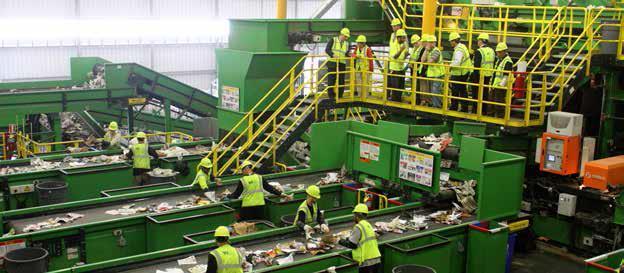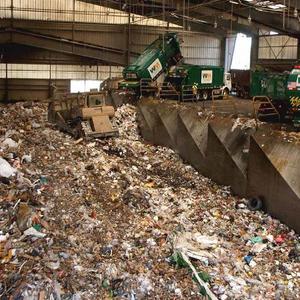Waste Management publishes 2014 sustainability report







Waste Management
December 31, 2014
BY Katie Fletcher
Waste Management recently released its 2014 sustainability report “Creating a Circular Economy,” which documents the company’s progress on recycling, energy production, transforming waste into valuable resources and helping businesses move toward zero waste. A sustainability report is published every two years. This one updates the 2012 report providing full-year data for 2012 and 2013.
Daniel Steiner, CEO of WM, said in the report the company’s waste-based energy revenues and generation were flat in 2013 with natural gas serving as a low-cost alternative. He said, the company recognized that achieving the 2020 goal of serving 2 million households with waste-based energy would be challenging.
Even with challenges, Steiner said, the company has made great progress towards achieving 2020 sustainability goals, and the challenges of 2013 have made employees smarter.
WM currently produces gas from landfills to provide power to over 470,000 households, and Steiner said the company plans to continue to invest in these projects and expand services to landfills owned by others.
In July 2014, WM entered into an agreement to sell Wheelabrator Technologies, the company’s waste-to-energy (WTE) business, to Energy Capital Partners. Following the close of the transaction in December, WM will enter into a long-term waste supply agreement with ECP. WM will still use waste to generate energy, but ownership of that energy will go to ECP. http://biomassmagazine.com/articles/11363/energy-capital-partners-closes-on-acquisition-of-wheelabrator
Wheelabrator Technologies unit operated 17 WTE plants in 2012 and 2013. Combined the plants processed more than 23,000 tons of waste per day, with the capacity to produce 5.3 gross kWh of power. In 2013, Wheelabrator sold more than 4.6 billion kWh and 2.1 million pounds of steam.
Advertisement
Advertisement
WM’s WTE plants can also provide green steam. One example of this is Wheelabrator’s WTE facility in Peekskill, New York, in partnership with a commercial laundry company, White Plains Linen, to supply steam directly to its 100,000-square-foot facility. The steam will power laundry equipment and heating systems, reducing the facility’s natural gas usage by more than 900,000 therms and cutting its carbon footprint by 90 percent.
WM manages 137 landfill-gas-to-energy (LFGTE) projects, which collectively generate 676 MW of power annually, 262 active solid-waste landfills and four independent power production plants—two of which are producing renewable energy—in addition to the 17 WTE plants.
The company is pursuing unique technologies to help its effort in converting waste into energy. One of the newest technologies is SpecFUEL, an engineered fuel that can be utilized in industrial boilers and kilns as a supplement to or replacement for fossil fuels. The fuel is made from post-recycled mixed waste. The process involves sorting equipment to remove recyclable metals, organics, PVC plastic and inert materials unsuitable for fuel. Remaining paper and plastic materials are transformed into the product. WM has a SpecFUEL plant in Philadelphia, which opened early 2014.
WM has also been developing technology to transform plastics into fuel using pyrolysis, which changes the chemical composition of organic material through exposure to high temperatures. WM has a plastics recovery facility, which began in its start-up phase in Portland, Oregon. The waste-plastic-to-synthetic-crude-oil facility processed 848 tons of plastics into 200,972 gallons of oil in 2013, which was delivered to Tacoma, Washington, oil refinery at market rates.
WM’s Saint Nicéphore LFGTE facility in Quebec, Canada, produces both electricity from landfill gas for the local utility Hydro-Quebec and uses residual heat created during power generation to heat local greenhouses.
Another project began in October 2013 at the Milam Landfill in Fairmont City, Illinois. A groundbreaking ceremony occurred for an on-site renewable-natural-gas facility said to begin operations this month. This is WM’s third project using landfill gas to power natural gas vehicles, in addition to their Altamont Landfill in California that produces 13,000 gallons of liquefied natural gas per day and another at a landfill in Ohio.
Advertisement
Advertisement
The facility will have the ability to process approximately 3,500 standard cubic feet per minute of incoming landfill gas—enough to fuel about 400 of WM’s compressed natural gas (CNG) collection trucks each day, and more than 10 percent of the gas used in the company’s entire CNG fleet.
At the end of 2013 WM owns 32,174 trucks total, 18,848 collection vehicles and 3,075 natural gas vehicles. Total the company has spent $315 million on natural gas vehicles, and as of mid-2014 WM has 67 fueling stations in the U.S. and Canada.
Company efforts at landfill sites include their investment in the development of gas-to-liquids (GTL) technology. The technology provides a method of converting landfill methane to syngas and then to high-value materials for the transportation and chemical industries. This technology is an option for facilities that cannot economically convert landfill gas to electricity.
In 2014, WM announced a joint venture with NRG Energy, Ventech Engineers Intentional and Velocys to use smaller-scale GTL technology to convert landfill gas co-fed with natural gas into renewable fuels and chemicals, such as cleaner-burning diesel and multi-purpose industrial wax. WM built an operation demonstration unit at Easy Oak Landfill outside of Oklahoma City, which has since successfully operated for more than 10,000 hours.
The 2014 sustainability report covered all components of WM’s business model, including reducing waste, growing recycling, extracting value from organics, recovering energy from waste, harnessing energy at landfills and reducing residuals.
Upcoming Events





